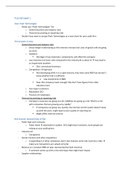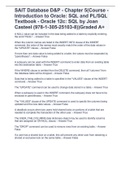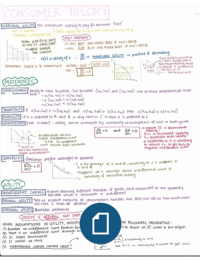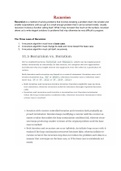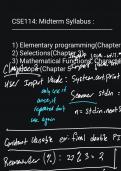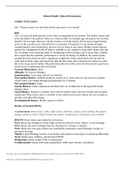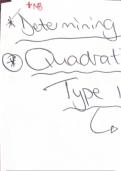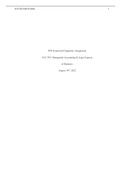Tutorial week 1
Case: Flash Technologies
- Study case “Flash Technologies” for:
o General business and industry risks
o Financial accounting or reporting risks
- Decide if you want to accept Flash Technologies as a new client for your audit firm
First answers in class
- General business and industry risks
o Gross margin is decreasing as the revenues increase but costs of goods sold are going
up more.
o Suppliers
▪ Shortage of raw materials / components, will affect the company
o Low inventory turnover ratio compared to the industry (8 vs about 2) → may lead to
an impairment problem
▪ Old / overvalued inventory
o Competition → high-tech
▪ Not developing while it is a rapid industry, they have some R&D but we don’t
know whether that is sufficient.
• Low investments in R&D
▪ Does this company invest enough? We don’t have figures from other
industries here
o Two major customers
o Reputation CEO
o Pressure on employees
- Financial accounting or reporting risks
o Company’s revenues are going up a lot, liabilities are going up a lot. What is a risk
with companies that are growing very rapidly?
▪ If companies are going very quickly, the internal control system doesn’t keep
up with the work, might lead to poor quality of reporting etc.
▪ Might affect internal controls
Risk Analysis: General Areas of Risk
- Public high-tech company
o Public listed → downside for auditor: CEO might face incentives, more people are
relying on your publications
- Industry risk
o Competitive
- Korean Venture and other acquisitions
o Is expanding in 2 other companies, but it also imposes some risks (currency risks) →
make sure transactions are valued correctly
- Reliance on 1 product (98% of sales represented by Flash memory)
o If someone comes up with a new technique that might have impact
- Supplier relationships
, o Shortage of raw materials / components will affect the company
- Two major customers account for 25% of the sales
- Extreme growth
- Short sales of stock increasing
o More investors expect the share price to go down, they only do that if they have
some reason for this (bad news, overvalued company)
- Flashwall 2017 sales to one company, which is or will be a related party
o There is no market for this product (no indication of prices)
- SEC investigation: we would like to know what the SEC is investigating
- Allegations concerning CEO
- AT&T contract might not go through
Risk Analysis: Financial Statement Risk
- Accounts receivable increased, but allowance for doubtful accounts & accounts payable did
not
- Increase in other current assets
- Inventory increase, turnover only 1.8
o Some inventory might be overvalued, doesn’t exist → might lead to write-offs
- Rapid increase in sales – revenue recognition issues
o If you see a company for which the sales are increasing by over 200%, then you want
to know if all of those sales actually occurred.
- Sales increased by 204%, general administrative expenses only increased by 36%
o It sounds weird, you would expect supporting activities also going up
- High increase in cost of goods sold
o Decrease in gross profits as a percentage of sales
o Apparently, there is already some competition
- Negative cashflows from operations
o Surprising: normally you would expect them to go in the same direction with sales
Risk Analysis: Flash and the Industry
- Low turnover ratio (1.8) compared to industry (8.1)
o Obsolete inventory?
- High operating profits (20%) relative to industry (14%)
- Flash is a small player
- Industry is rapidly changing and extremely competitive
- R&D expenses seems relatively low
Positive aspects of Flash
- Strong cash position
- PC Card market is leading edge with a lot of potential
- Alliances with reputable firms
- Strong growth
- Excellent market performance
- ISO 9001 certified
,The Truth
- Case based on real company: Centennial Technologies
- CEO: Emanual “Manny” Pinez
- Large scale accounting fraud: approx. $23 million in fictious revenue
- Fraud spread out over a number of years
- Management fraud
About Emanual Pinez
- Claimed to have a degree from the Hebrew University, and a master’s degree from the
London School of Economics
- Fired from a Swiss computer company in 1971 for phony invoices
o Prepared but never sent out, but still booked as revenues
- CEO of ABL Technologies in early 1980’s which was involved in many lawsuits
- Claimed to have set a new world record swimming across the English Channel in 1958 (10
hours, 21 minutes)
- Said he was a paratrooper in the Israeli Army
- Pathological liar according to his wife
- Flamboyant (lover of fast cars, wine, food)
- Claimed to be close to a $300 million sales deal with AT&T
- Claimed to have never profited from the fraud (but used his shares as collateral for a $18.5
million loan)
The Fraud
- Flash 98 scam
o Cost 10 cents, sales price $500 (did in fact not exist)
o Sold to only 1 company (BBC computers)
o $1 million dollar wired by Pinez to St. Jude Management Corp (also his company),
which then paid Centennial on behalf of BBC Computers
▪ The products went out from Flash to BBC, and then Jude would ‘pay’ on
behalf of BBC
- PC Card scam
o Investor saw: “a room full of people banging on cards with rubber mallets” –
Subsequently dumped all Centennial shares
▪ They started producing cases, if those cases are defective, then they will be
sent back and restored. But there wasn’t any technology → this didn’t exist.
The only thing they did was making these outside cases.
o Fake cards sold to companies controlled by Pinez
- Fruit basket scheme
o Weights couple of kilos, memories weigh nothing, took shipping information
o Weighted before sending
o Used for paperwork to convince auditor packages with memory cards were sent to
customers
Financial restatements
- Sales were reduced from $37.8 to $33.4 million
- COGS was increased from $23.6 to $29.7 million
, - Net income went from a profit of $5 million to loss $4.2 million
- Inventory was reduced from $18 to $8 million
- PPE was reduced from $4.6 to $2 million
- Stockholder Equity was reduced from $45 to $32 million
- Cumulative adjustments:
o Reduction sales revenue by $21.2 million
o Increase COGS by $8.8 million
o Write-offs investments and advances of $15.8 million
→ Centennial was eligible for an $8.1 million federal tax refund!
How was the fraud detected?
- Auditor: Coopers & Lybrand → indicated it was a high-risk client
- Classified Centennial as “high-level risk alert” in 1996
- 1997: Auditor noticed “fishy bill and hold transactions” → revenue but no invoices were sent
out
- Informed board of directors and requested full financial review
- CFO James M. Murphy indicated Pinez as the mastermind behind the fraud
Aftermath
- Pinez sentenced to 5 years in prison
- Ordered to pay restitution of $150 million
- Paid $5.3 million to settle a civil complaint
- Chief Financial Officer (CFO), J.M. Murphy, sentenced to 15 months in a halfway house.
Ordered to make the same restitution.
- Chief Operating Officer (COO), B. Fletcher, sentenced to 15 months in a halfway house.
Ordered to pay $7 million restitution.
- SEC filed complaints against Murphy and Peretz (business partner who accepted a fruit
basket, claiming it were products)
o Peretz: business partner and friend of CEO, he said to the auditors that he received
products (instead of fruit baskets).
- Four days before Pinez was fired he placed an order for 5,400 option contracts betting the
stock would fall; proceeds were frozen
- Centennial survived the fraud and returned to profitability
- In 1999 Intel took a 16 percent share in Centennial and in 2001 Giant Solectron Corp.
purchased the company for almost $22 per share.
Tutorial week 2
Ethics in accounting & client acceptance
Is Audit Partner Identification Useful? Evidence from the KPMG ‘Steal the Exam’ Scandal
The Scandal
- PCAOB: oversight body (in the Netherlands AFM) → works in public interest
Case: Flash Technologies
- Study case “Flash Technologies” for:
o General business and industry risks
o Financial accounting or reporting risks
- Decide if you want to accept Flash Technologies as a new client for your audit firm
First answers in class
- General business and industry risks
o Gross margin is decreasing as the revenues increase but costs of goods sold are going
up more.
o Suppliers
▪ Shortage of raw materials / components, will affect the company
o Low inventory turnover ratio compared to the industry (8 vs about 2) → may lead to
an impairment problem
▪ Old / overvalued inventory
o Competition → high-tech
▪ Not developing while it is a rapid industry, they have some R&D but we don’t
know whether that is sufficient.
• Low investments in R&D
▪ Does this company invest enough? We don’t have figures from other
industries here
o Two major customers
o Reputation CEO
o Pressure on employees
- Financial accounting or reporting risks
o Company’s revenues are going up a lot, liabilities are going up a lot. What is a risk
with companies that are growing very rapidly?
▪ If companies are going very quickly, the internal control system doesn’t keep
up with the work, might lead to poor quality of reporting etc.
▪ Might affect internal controls
Risk Analysis: General Areas of Risk
- Public high-tech company
o Public listed → downside for auditor: CEO might face incentives, more people are
relying on your publications
- Industry risk
o Competitive
- Korean Venture and other acquisitions
o Is expanding in 2 other companies, but it also imposes some risks (currency risks) →
make sure transactions are valued correctly
- Reliance on 1 product (98% of sales represented by Flash memory)
o If someone comes up with a new technique that might have impact
- Supplier relationships
, o Shortage of raw materials / components will affect the company
- Two major customers account for 25% of the sales
- Extreme growth
- Short sales of stock increasing
o More investors expect the share price to go down, they only do that if they have
some reason for this (bad news, overvalued company)
- Flashwall 2017 sales to one company, which is or will be a related party
o There is no market for this product (no indication of prices)
- SEC investigation: we would like to know what the SEC is investigating
- Allegations concerning CEO
- AT&T contract might not go through
Risk Analysis: Financial Statement Risk
- Accounts receivable increased, but allowance for doubtful accounts & accounts payable did
not
- Increase in other current assets
- Inventory increase, turnover only 1.8
o Some inventory might be overvalued, doesn’t exist → might lead to write-offs
- Rapid increase in sales – revenue recognition issues
o If you see a company for which the sales are increasing by over 200%, then you want
to know if all of those sales actually occurred.
- Sales increased by 204%, general administrative expenses only increased by 36%
o It sounds weird, you would expect supporting activities also going up
- High increase in cost of goods sold
o Decrease in gross profits as a percentage of sales
o Apparently, there is already some competition
- Negative cashflows from operations
o Surprising: normally you would expect them to go in the same direction with sales
Risk Analysis: Flash and the Industry
- Low turnover ratio (1.8) compared to industry (8.1)
o Obsolete inventory?
- High operating profits (20%) relative to industry (14%)
- Flash is a small player
- Industry is rapidly changing and extremely competitive
- R&D expenses seems relatively low
Positive aspects of Flash
- Strong cash position
- PC Card market is leading edge with a lot of potential
- Alliances with reputable firms
- Strong growth
- Excellent market performance
- ISO 9001 certified
,The Truth
- Case based on real company: Centennial Technologies
- CEO: Emanual “Manny” Pinez
- Large scale accounting fraud: approx. $23 million in fictious revenue
- Fraud spread out over a number of years
- Management fraud
About Emanual Pinez
- Claimed to have a degree from the Hebrew University, and a master’s degree from the
London School of Economics
- Fired from a Swiss computer company in 1971 for phony invoices
o Prepared but never sent out, but still booked as revenues
- CEO of ABL Technologies in early 1980’s which was involved in many lawsuits
- Claimed to have set a new world record swimming across the English Channel in 1958 (10
hours, 21 minutes)
- Said he was a paratrooper in the Israeli Army
- Pathological liar according to his wife
- Flamboyant (lover of fast cars, wine, food)
- Claimed to be close to a $300 million sales deal with AT&T
- Claimed to have never profited from the fraud (but used his shares as collateral for a $18.5
million loan)
The Fraud
- Flash 98 scam
o Cost 10 cents, sales price $500 (did in fact not exist)
o Sold to only 1 company (BBC computers)
o $1 million dollar wired by Pinez to St. Jude Management Corp (also his company),
which then paid Centennial on behalf of BBC Computers
▪ The products went out from Flash to BBC, and then Jude would ‘pay’ on
behalf of BBC
- PC Card scam
o Investor saw: “a room full of people banging on cards with rubber mallets” –
Subsequently dumped all Centennial shares
▪ They started producing cases, if those cases are defective, then they will be
sent back and restored. But there wasn’t any technology → this didn’t exist.
The only thing they did was making these outside cases.
o Fake cards sold to companies controlled by Pinez
- Fruit basket scheme
o Weights couple of kilos, memories weigh nothing, took shipping information
o Weighted before sending
o Used for paperwork to convince auditor packages with memory cards were sent to
customers
Financial restatements
- Sales were reduced from $37.8 to $33.4 million
- COGS was increased from $23.6 to $29.7 million
, - Net income went from a profit of $5 million to loss $4.2 million
- Inventory was reduced from $18 to $8 million
- PPE was reduced from $4.6 to $2 million
- Stockholder Equity was reduced from $45 to $32 million
- Cumulative adjustments:
o Reduction sales revenue by $21.2 million
o Increase COGS by $8.8 million
o Write-offs investments and advances of $15.8 million
→ Centennial was eligible for an $8.1 million federal tax refund!
How was the fraud detected?
- Auditor: Coopers & Lybrand → indicated it was a high-risk client
- Classified Centennial as “high-level risk alert” in 1996
- 1997: Auditor noticed “fishy bill and hold transactions” → revenue but no invoices were sent
out
- Informed board of directors and requested full financial review
- CFO James M. Murphy indicated Pinez as the mastermind behind the fraud
Aftermath
- Pinez sentenced to 5 years in prison
- Ordered to pay restitution of $150 million
- Paid $5.3 million to settle a civil complaint
- Chief Financial Officer (CFO), J.M. Murphy, sentenced to 15 months in a halfway house.
Ordered to make the same restitution.
- Chief Operating Officer (COO), B. Fletcher, sentenced to 15 months in a halfway house.
Ordered to pay $7 million restitution.
- SEC filed complaints against Murphy and Peretz (business partner who accepted a fruit
basket, claiming it were products)
o Peretz: business partner and friend of CEO, he said to the auditors that he received
products (instead of fruit baskets).
- Four days before Pinez was fired he placed an order for 5,400 option contracts betting the
stock would fall; proceeds were frozen
- Centennial survived the fraud and returned to profitability
- In 1999 Intel took a 16 percent share in Centennial and in 2001 Giant Solectron Corp.
purchased the company for almost $22 per share.
Tutorial week 2
Ethics in accounting & client acceptance
Is Audit Partner Identification Useful? Evidence from the KPMG ‘Steal the Exam’ Scandal
The Scandal
- PCAOB: oversight body (in the Netherlands AFM) → works in public interest

